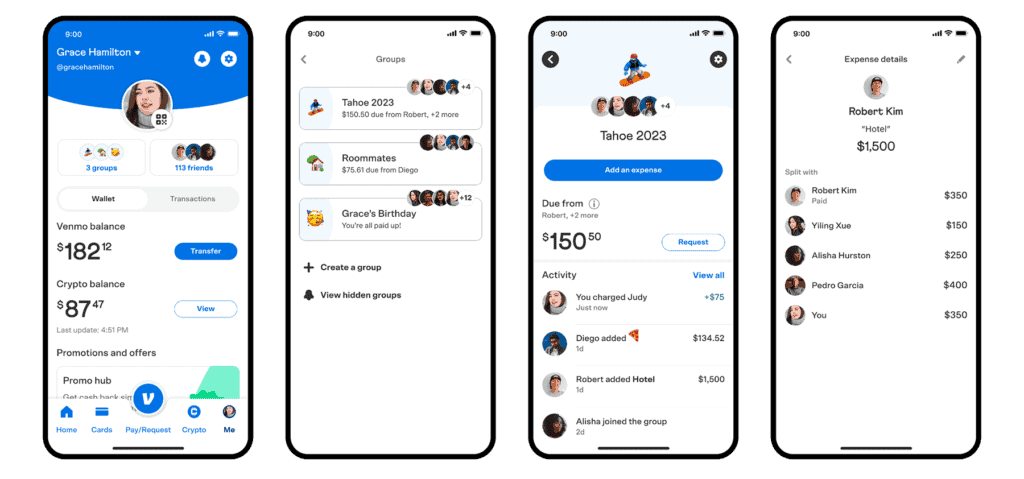Zelle and Venmo are popular apps that make it easy to send money to friends and family. Zelle works with many banks and credit unions, while Venmo is a separate app with more social features. Both apps are essential for quick and convenient money transfers in today’s digital age. They have unique features and benefits.
Zelle transfers money directly from your bank account to another person’s account, while Venmo allows you to keep money in the app and has a feed where you can see your friends’ payments. Zelle is good for fast, simple transfers to people you trust, while Venmo works well for splitting costs and paying in stores that accept it. Depending on your needs, you can choose between Zelle and Venmo.
Peer-to-Peer Payments: A Comparison of Zelle and Venmo

Fees and Transfer Speed
| Feature | Zelle | Venmo |
|---|---|---|
| Standard Transfers | Free | Free |
| Instant Transfers | Not available | 1.75% fee (min $0.25, max $25) |
| Transfer Speed | Minutes | 1-3 business days (instant with fee) |
Additional Features
| Feature | Zelle | Venmo |
|---|---|---|
| Social Feed | No | Yes |
| Splitting Bills | Limited | Yes |
| Merchant Payments | Limited | Yes |
| Cryptocurrency Support | No | Yes |
Security
Both Zelle and Venmo offer security measures such as data encryption and fraud monitoring. However, Zelle is integrated with your bank’s security systems, potentially offering an extra layer of protection.

User Experience
Zelle is generally considered more straightforward, with a simple interface focused on sending and receiving money. Venmo offers a more social experience, with a feed for sharing payments and interacting with friends.
Accessibility
Zelle is available through many major banks and credit unions, making it accessible to a wide range of users. Venmo requires a separate app and account.
Best For
- Zelle: Quick, free transfers between friends and family with bank accounts.
- Venmo: Social payments, splitting bills, and those interested in cryptocurrency.
Key Takeaways
- Zelle links to bank accounts for quick transfers
- Venmo offers a social feed and in-store payment options
- Both apps are free for basic person-to-person payments
Comparing Key Features and User Experience
Zelle and Venmo offer different features and user experiences. Each app has its own strengths in ease of use, functionality, and unique aspects.
Ease of Use and Accessibility
Zelle is built into many bank apps. Users can send money through their existing banking app. This makes it easy for people who already use online banking. No need to download a new app or create a new account.
Venmo needs its own app. Users must sign up for a separate account. But the app is user-friendly. It has a simple design that’s easy to navigate.
Both apps let users send money with just a phone number or email. Venmo also allows transfers to usernames. This can be helpful when you don’t have someone’s contact info.
Range of Functionality
Zelle focuses on quick, simple transfers. It’s best for sending money to friends and family. The app doesn’t store funds. Money moves directly between bank accounts.
Venmo offers more features. It has a social feed where users can see friends’ transactions. Users can add notes and emojis to payments. Venmo also has a digital wallet. This lets users keep a balance in the app.
Both apps allow instant transfers for a fee. Standard transfers are free but take a few days. Venmo users can also pay at some stores with the app or a Venmo debit card.
Unique Aspects of Each Service
Zelle stands out for its bank integration. It’s fast and secure. Many banks set higher transfer limits for Zelle than other apps. But Zelle lacks social features.
Venmo shines in its social aspects. Users can split bills and share payments with friends. The app also supports QR code payments. This makes it easy to pay in person.
Venmo offers more payment options. Users can link credit cards or use their Venmo balance. Zelle only works with bank accounts and debit cards.
Zelle is better for large transfers. Venmo has lower limits. But Venmo is more widely accepted for small purchases at stores and restaurants.
Security and Trust
Zelle and Venmo use strong safety measures to protect users’ money and data. Both apps employ encryption and fraud checks to keep transactions secure.
Protecting User Information and Funds
Zelle and Venmo use data encryption to safeguard personal details. They require users to set up passwords and PINs. Many banks also offer multifactor authentication for extra security.
Venmo lets users hide their transactions from others. This keeps payment activity private. Users can adjust these settings in the app.
Zelle works through bank apps. It uses the same security as online banking. This includes fraud monitoring systems to spot unusual activity.
Addressing Fraud and Unauthorized Transactions
Both services have teams that watch for scams. They work to stop fraud before it happens. If fraud does occur, users should contact customer support right away.
Zelle and Venmo tell users to only send money to people they know and trust. This helps prevent scams. They also warn about common tricks that bad actors use.
If someone loses their phone, they can log out of the app remotely. This stops others from using their account.
Institutional Support and Insurance
Zelle is backed by major U.S. banks. It’s run by Early Warning Services, a company owned by seven large banks. This gives it strong support.
Money in Venmo accounts isn’t FDIC insured. But funds in linked bank accounts are protected. Venmo is owned by PayPal, a trusted name in online payments.
For both apps, bank transfers are covered by FDIC insurance. This protects users if their bank fails. The coverage is up to $250,000 per account.
Frequently Asked Questions
Zelle and Venmo have key differences in safety, popularity, features, and use cases. Let’s look at some common questions about these payment apps.
Which is safer for transactions, Zelle or Venmo?
Both Zelle and Venmo use encryption to protect user data. Zelle links directly to bank accounts, which can be safer for large transfers. Venmo offers purchase protection for some transactions. Users should be careful when sending money to strangers on either platform.
What are the differences in popularity between Zelle and Venmo?
Venmo is more popular with younger users and for social payments. Zelle is often used for larger transfers and by older adults. Many banks offer Zelle built into their apps. Venmo has a larger user base overall.
How do Zelle and Venmo compare to Cash App?
Cash App works like Venmo, with a digital wallet and social features. Zelle moves money directly between bank accounts. Cash App lets users buy stocks and Bitcoin. All three apps allow free transfers to friends and family.
Are there tax implications for using Zelle or Venmo?
The IRS requires reporting of business transactions over $600 per year on payment apps. This applies to both Zelle and Venmo. Personal transfers like gifts or splitting costs with friends are not taxable.
What are the disadvantages of using Zelle for money transfers?
Zelle doesn’t have a digital wallet to store funds. It can be hard to cancel or reverse transfers. Not all banks support Zelle. There’s no buyer protection for purchases. Daily and weekly transfer limits may be lower than other apps.
How do Zelle and Venmo differ when used for marketplaces like Facebook?
Venmo works well for marketplace sales due to its social features. It shows a public feed of transactions. Zelle is less common for online marketplaces. It lacks tools for buyers and sellers. Facebook Marketplace prefers bank transfers or cash for in-person sales.







